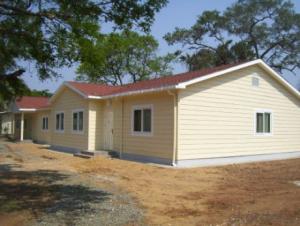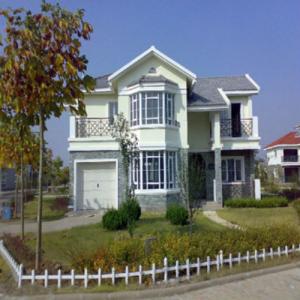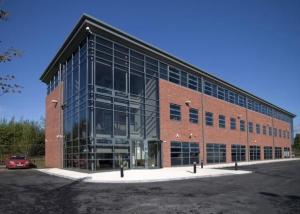Anti-seismic Light gauge steel modular house
- Loading Port:
- China Main Port
- Payment Terms:
- TT OR LC
- Min Order Qty:
- -
- Supply Capability:
- -
OKorder Service Pledge
Quality Product, Order Online Tracking, Timely Delivery
OKorder Financial Service
Credit Rating, Credit Services, Credit Purchasing
You Might Also Like
The adavantages of the light gauge steel villa:
1. Better thermal insulation
The advanced exterior overall thermal insulation meets the updated state energy-saving standards for buildings. It refrains from the cold and thermal bridges phenomenon, and keeps buildings away from damages such as dampness, distortion, mildew and corrosion.
The unique heat reflection and ventilation layer design can make better insulation effects. Temperature can be reduced by five to eight degrees. ( In my opinion, this advantage is very suitable for the climatic condition of Middle East )
2. Seismic and Wind Resistance
Withstand the shock of 9 on the Richter scale. The dense light gauge steel and column are connected in flexible method with screws and bolts, which can abosorb the energy of eathquake. There are fittings between foundation and wall, which are resistant to pull out and shear. The total weight of the house is light, which is only 1/6 of the conventional concrete houses. Therefore it has better anti-seismic performance.
Can endure typhoon of 12 levels
There are special fittings among roof, floor, wall and foundation. The strong connection can help resist typhoon of 12 levels.
3. Roof Load-bearing and Fireproof
The structure can be designed according to climate requirements.
Wall and floor slab use special technology which can meet 3h refractory limit.
4. Sound insulation
Improved technology on sound insulation and shock absorption meet the state building standards for sound insulation. Special methods are performed, especially towards the audio frequency ranging from 250-1000Hz which is the most sensitive to ears, in order to create a quiet and comfortable living environment.
5. Moisture-proof and Ventilation
There is a gap between wall and roof truss, so the air can flow inside.
There is one-way ventilation layer in the composite wall, which is able to make the wall "breath". This means moisture can be reduced inside the door.
6. Durable (90 years structure safty guarantee)
Special coating technology enables the structural materials to have the self-restoration function to prevent rust and corrosion.
Envelope materials using new light weight building materials to achieve fire resistant, anti-corrosion and anto-moth.
7. Energy Efficient and Enviromental Protection
Energy Saving: 65-90 energy redution.
Water Saving: The dry construction consumes 10% of water used in traditional constrution.
Land Saving: The inside usable area increases 10%
Environment Protection: Pollution-free construction system.
- Q:Can container houses be built with a solar power system?
- Container houses have the capability to be constructed with a solar power system. In reality, container houses are frequently considered ideal candidates for solar power due to their modular and portable nature. The roof of a container house can conveniently be equipped with solar panels to capture the sun's energy and transform it into electricity. These panels, comprised of photovoltaic cells, can generate electricity throughout the day and store it in batteries for use at night or on overcast days. The size of the solar power system will be determined by the energy requirements of the container house, but with advancements in solar technology, it is possible to solely power an entire container house with solar energy. Furthermore, container houses are often designed with energy-efficient characteristics like insulation and double-glazed windows, which further enhance the use of solar power by decreasing energy consumption. All in all, container houses and solar power systems are a perfect combination, providing sustainable and environmentally friendly living solutions.
- Q:Can container houses be insulated for extreme climates?
- Indeed, container houses have the capability to be insulated for extreme climates. The use of shipping containers as a building material offers inherent strength and durability, enabling them to withstand severe weather conditions. To insulate a container house for extreme climates, multiple methods can be utilized. One frequently employed technique involves applying insulation material to the interior walls of the container. This can be achieved by utilizing rigid foam insulation boards or spray foam insulation. These materials possess exceptional thermal resistance, effectively maintaining a stable interior temperature, even in extremely hot or cold climates. To further enhance insulation, it is advisable to install double-glazed windows and insulated doors. By doing so, heat loss or gain through these areas can be prevented, ensuring a comfortable interior regardless of external temperatures. Moreover, it is crucial to properly seal any gaps or openings in the container to prevent air leakage, which can compromise the insulation. This can be accomplished by using weatherstripping or caulking to seal gaps around windows, doors, and any other potential entry points for air. Additionally, incorporating passive design strategies can contribute to improved insulation in container houses. This includes orienting the house to maximize natural sunlight, utilizing shading devices to minimize heat gain in hot climates, and implementing ventilation strategies to promote air circulation and reduce reliance on mechanical cooling or heating. In conclusion, container houses can certainly be insulated for extreme climates. Through the utilization of various insulation techniques, sealing gaps, and incorporating passive design strategies, container houses can be made comfortable and energy-efficient, even in the most challenging weather conditions.
- Q:Can container houses withstand natural disasters?
- Container houses have demonstrated a certain level of resilience against natural disasters. The robust and long-lasting nature of the shipping containers used in their construction inherently grants them resistance against specific calamities like earthquakes and powerful winds. The containers' structural integrity enables them to endure the forces exerted during such occurrences. Furthermore, container houses can serve as secure and protected shelters amidst hurricanes and tornadoes. Nevertheless, it is crucial to acknowledge that the extent of their resilience may fluctuate based on the container house's design, construction, and location. Implementing appropriate reinforcement and engineering methods can additionally bolster their capacity to withstand natural disasters.
- Q:Single-family villas, townhouses, Shuangpin villas, stacked fight the definition of the villas are what?
- independent villa: that is unique, private strong single villa, this type is the villa's oldest one, but also the ultimate form of villa architecture.
- Q:What is the cost of sandwich color steel room?
- Widely used in large public buildings, public buildings, activities board room, and integrated housing walls and roofs
- Q:Are container houses easy to transport during the construction process?
- Yes, container houses are relatively easy to transport during the construction process. One of the major advantages of using shipping containers for housing is their portability. These containers are designed to be transported across long distances on ships, trains, and trucks, making them highly mobile. During the construction process, container houses can be easily transported to the desired location using trucks or cranes. This eliminates the need for extensive on-site construction and allows for faster and more efficient building. Additionally, since the containers are already built to withstand transportation stresses, they can be easily moved without compromising their structural integrity. Furthermore, container houses can be easily disassembled and transported to a new location if needed. This flexibility is particularly appealing for individuals or organizations that require temporary or mobile housing solutions. However, it is important to note that the ease of transportation may depend on the size and weight of the container house, as well as the accessibility of the construction site. In some cases, specialized equipment or permits may be required to transport larger or heavier container houses. Nonetheless, overall, container houses offer a convenient and practical solution for portable housing.
- Q:What are the limitations of container houses?
- Container houses have gained popularity in recent years due to their affordability, sustainability, and flexibility. However, like any other housing option, they also have limitations that need to be considered. Firstly, the size of a container house is limited by the dimensions of shipping containers, typically 8 feet wide, 8.5 feet tall, and available in lengths of 20 or 40 feet. While multiple containers can be joined together to create larger spaces, there are still inherent space constraints. This can be challenging for those looking for larger living spaces or families with multiple members. Furthermore, container houses often require additional insulation to make them suitable for living. The metal walls of shipping containers are not naturally well-insulated, which can lead to issues with temperature regulation. Adequate insulation is necessary to prevent extreme heat or cold, as well as condensation problems that can arise from temperature differentials. Another limitation is the need for structural modifications. Shipping containers are not originally designed to be used as living spaces, so structural reinforcements are often required to ensure their stability and safety. This can add to the overall cost and complexity of the construction process. Additionally, container houses may face zoning and building code restrictions. Some areas have regulations that do not permit the use of shipping containers as permanent housing, or they may have specific requirements that need to be met for safety and aesthetic reasons. It is important to research and comply with local regulations before pursuing a container house project. Lastly, customization and design options can be limited. The rigid structure of shipping containers can restrict architectural possibilities, making it difficult to achieve certain design aesthetics or unique layouts. While creative solutions can be found, it may require extra effort and planning to achieve the desired look and functionality. In conclusion, container houses offer numerous advantages, but they also come with limitations that should be taken into account. These include size constraints, insulation requirements, structural modifications, zoning restrictions, and limited customization options. By considering these limitations, individuals can make informed decisions about whether a container house is the right choice for them.
- Q:Can container houses be easily moved?
- Yes, container houses can be easily moved. Due to their modular design and standardized dimensions, container houses can be transported using trucks, ships, or trains. This mobility allows for flexible relocation and adaptability to different locations or situations.
- Q:What is the cost of a container house?
- The cost of a container house can vary significantly depending on various factors such as the size, design, customization, location, and additional features. On average, a basic container house can cost anywhere between $20,000 to $50,000. However, more luxurious and larger container homes can range from $50,000 to $200,000 or even higher. It's important to consider all these factors when determining the cost of a container house.
- Q:Are container houses suitable for yoga or wellness retreats?
- Container houses can be suitable for yoga or wellness retreats. The open and flexible design of container houses allows for the creation of spacious and peaceful environments, perfect for hosting yoga sessions and wellness activities. Additionally, their eco-friendly nature aligns well with the values often associated with these retreats. With proper interior design and customization, container houses can provide a unique and inviting space for participants to relax, rejuvenate, and connect with nature.
1. Manufacturer Overview |
|
|---|---|
| Location | |
| Year Established | |
| Annual Output Value | |
| Main Markets | |
| Company Certifications | |
2. Manufacturer Certificates |
|
|---|---|
| a) Certification Name | |
| Range | |
| Reference | |
| Validity Period | |
3. Manufacturer Capability |
|
|---|---|
| a)Trade Capacity | |
| Nearest Port | |
| Export Percentage | |
| No.of Employees in Trade Department | |
| Language Spoken: | |
| b)Factory Information | |
| Factory Size: | |
| No. of Production Lines | |
| Contract Manufacturing | |
| Product Price Range | |
Send your message to us
Anti-seismic Light gauge steel modular house
- Loading Port:
- China Main Port
- Payment Terms:
- TT OR LC
- Min Order Qty:
- -
- Supply Capability:
- -
OKorder Service Pledge
Quality Product, Order Online Tracking, Timely Delivery
OKorder Financial Service
Credit Rating, Credit Services, Credit Purchasing
Similar products
New products
Hot products
Related keywords



























